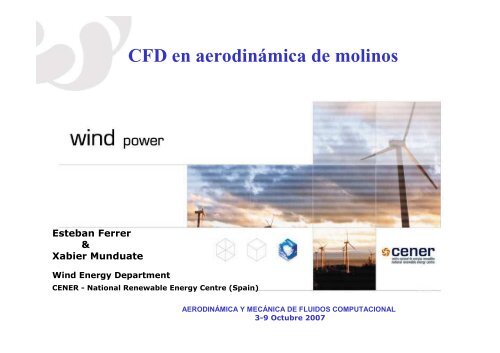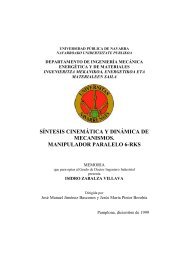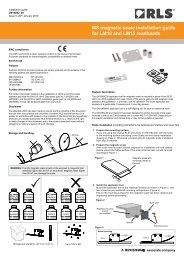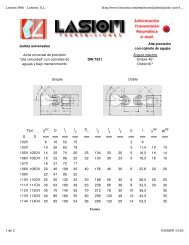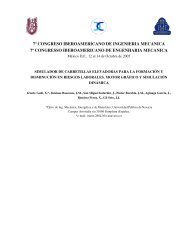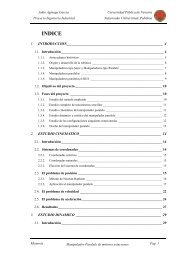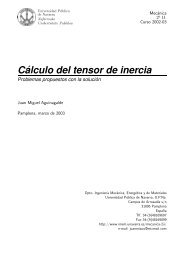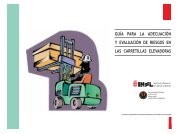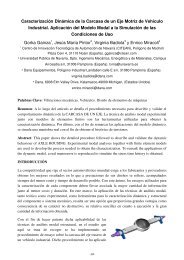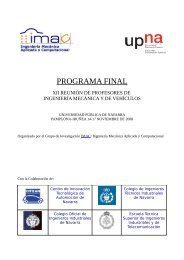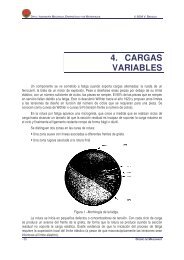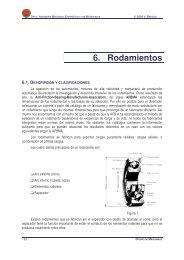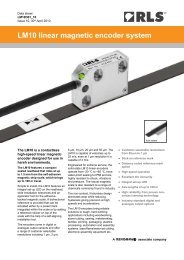CFD en aerodinámica de molinos - IngenierÃa Mecánica Aplicada y ...
CFD en aerodinámica de molinos - IngenierÃa Mecánica Aplicada y ...
CFD en aerodinámica de molinos - IngenierÃa Mecánica Aplicada y ...
Create successful ePaper yourself
Turn your PDF publications into a flip-book with our unique Google optimized e-Paper software.
<strong>CFD</strong> <strong>en</strong> aerodinámica <strong>de</strong> <strong>molinos</strong><br />
Esteban Ferrer<br />
&<br />
Xabier Munduate<br />
Wind Energy Departm<strong>en</strong>t<br />
CENER - National R<strong>en</strong>ewable Energy C<strong>en</strong>tre (Spain)<br />
AERODINÁMICA Y MECÁNICA DE FLUIDOS COMPUTACIONAL<br />
3-9 Octubre 2007
Sumario -1<br />
Introducción<br />
<br />
<strong>CFD</strong> <strong>en</strong> aerodinámica <strong>de</strong> <strong>molinos</strong><br />
(Aplicaciones CENER)<br />
Estudios <strong>de</strong> Perfiles<br />
• Complem<strong>en</strong>tar estudios túnel <strong>de</strong> curvas<br />
Cl/Cd/Cm vs alfa<br />
» Extrapolación <strong>en</strong> Re<br />
» Extrapolación <strong>en</strong> alfas<br />
» Estudios <strong>de</strong> rugosidad<br />
» Efecto <strong>de</strong> <strong>de</strong>formaciones locales (icing)<br />
• Dispositivos <strong>de</strong> hipersust<strong>en</strong>tación<br />
» Control pasivo<br />
Vortex g<strong>en</strong>erators<br />
» Control activo<br />
Soplido, succion<br />
Microtaps, flaps, etc..<br />
Efectos dinámicos (2D/3D unsteady)<br />
• Plunging/flaping, torion and edgewise translation<br />
• Dynamic stall<br />
• Dynamic inflow<br />
Aeroacustica <strong>de</strong> perfiles<br />
Cuantificar efectos 3D<br />
• Raíz (cambio 2D/3D)<br />
• Efecto <strong>de</strong> punta <strong>de</strong> pala (tip vortex)<br />
Terr<strong>en</strong>o complejo<br />
Estelas <strong>de</strong> aerog<strong>en</strong>eradores
Sumario -2<br />
Estudio <strong>de</strong> punta <strong>de</strong> palas<br />
Conceptos <strong>de</strong> aerodinámica<br />
• Alas finitas<br />
• Vortice <strong>de</strong> punta<br />
Caso <strong>de</strong> Estudio<br />
• Consi<strong>de</strong>raciones <strong>de</strong> diseño<br />
• Estudio aerodinámico <strong>de</strong> punta<br />
Ruido<br />
Conceptos básicos<br />
¿Como computar ruido?<br />
Transición <strong>en</strong> <strong>CFD</strong><br />
Conceptos básicos<br />
¿Cómo computar transición?<br />
Conclusiones
Introducción:<br />
¿ Don<strong>de</strong> usar <strong>CFD</strong> <strong>en</strong><br />
aerodinámica <strong>de</strong><br />
aerog<strong>en</strong>eradores ?
<strong>CFD</strong><br />
Coste computacional alto<br />
Difícil <strong>de</strong> utilizar (pre y post)<br />
Condiciones<br />
iniciales<br />
geometría<br />
<strong>CFD</strong><br />
Fuerzas<br />
mom<strong>en</strong>tos<br />
Mo<strong>de</strong>lo <strong>de</strong><br />
Turbul<strong>en</strong>cia<br />
y<br />
transición
BEM<br />
Muy rápidos<br />
Fácil <strong>de</strong> utilizar<br />
Acoplados con códigos estructurales<br />
geometría<br />
Corrección<br />
Curvas 2D/3D<br />
Corrección<br />
punta<br />
y<br />
raíz<br />
Cl-alfa 2D<br />
Cd-alfa 2D<br />
Cm-alfa 2D<br />
BEM<br />
Fuerzas<br />
mom<strong>en</strong>tos<br />
Condiciones<br />
Iniciales<br />
{<strong>en</strong> g<strong>en</strong>eral no coincid<strong>en</strong><br />
(Re, Turb)}<br />
Otras correciones<br />
Yaw, efecto torre,<br />
dynamic stall, etc…
BEM<br />
<strong>CFD</strong><br />
<strong>CFD</strong><br />
geometría<br />
Corrección<br />
Curvas 2D/3D<br />
Corrección<br />
punta<br />
y<br />
raíz<br />
Cl-alfa 2D<br />
Cd-alfa 2D<br />
Cm-alfa 2D<br />
BEM<br />
Fuerzas<br />
mom<strong>en</strong>tos<br />
<strong>CFD</strong><br />
Condiciones<br />
Iniciales<br />
{<strong>en</strong> g<strong>en</strong>eral no coincid<strong>en</strong><br />
(Re, Turb)}<br />
Otras correciones<br />
Yaw, efecto torre,<br />
dynamic stall, etc…<br />
<strong>CFD</strong><br />
<strong>CFD</strong>
Recordatorio limitaciones BEM<br />
Métodos basados <strong>en</strong> elem<strong>en</strong>tos <strong>de</strong> pala 2D<br />
Cada sección es in<strong>de</strong>p<strong>en</strong>di<strong>en</strong>te <strong>de</strong> la contigua<br />
Las fuerzas que actúan <strong>en</strong> una sección BEM se correspond<strong>en</strong> a las fuerzas<br />
resultantes <strong>en</strong> un perfil 2D<br />
Efectos 3D no son t<strong>en</strong>idos <strong>en</strong> cu<strong>en</strong>ta (<strong>en</strong> particular efecto <strong>de</strong> punta y raíz <strong>de</strong><br />
pala)<br />
Efectos 3D si hay separación no se ti<strong>en</strong><strong>en</strong> <strong>en</strong> cu<strong>en</strong>ta<br />
(Separación 3D ≠ separación 2D)<br />
La separación es 2D (t<strong>en</strong>ida <strong>en</strong> cu<strong>en</strong>ta <strong>en</strong> curvas Cl-alfa)
<strong>CFD</strong> <strong>en</strong><br />
aerodinámica<br />
<strong>de</strong> <strong>molinos</strong>
Estudio <strong>de</strong> perfiles
Perfiles 2D: Estáticos<br />
BEM y métodos <strong>de</strong> estelas necesitan curvas 2D (corregidas a 3D)<br />
Complem<strong>en</strong>tar estudios experim<strong>en</strong>tales <strong>en</strong> túnel <strong>de</strong><br />
curvas Cl/Cd/Cm vs alfa<br />
Extra/Interpolación <strong>en</strong> Re<br />
Extra/Interpolación <strong>en</strong> Mach (perfiles <strong>en</strong> offshore)<br />
Extra/Interpolación <strong>en</strong> alfas<br />
Estudios <strong>de</strong> rugosidad<br />
Efecto <strong>de</strong> <strong>de</strong>formaciones locales (icing)
Perfiles 2D: Estáticos
Perfiles 2D: Estáticos
Perfiles 2D: Estáticos
Dispositivos <strong>de</strong><br />
hipersust<strong>en</strong>tación
Técnicas <strong>de</strong> control pasivas:<br />
Vortex g<strong>en</strong>erators<br />
Gurney flaps<br />
Serrated trailing edges<br />
Special purpose airfoils (restrained max. lift; high lift; blunt trailing edge)<br />
Técnicas <strong>de</strong> control activas<br />
Permit<strong>en</strong> ‘controlar’ las variaciones ambi<strong>en</strong>tales y cambio <strong>en</strong> fuerzas<br />
<strong>de</strong>bido a rafagas, turbul<strong>en</strong>cia, cambios <strong>en</strong> direccion <strong>de</strong> vi<strong>en</strong>to, etc.<br />
Actively control the loading on bla<strong>de</strong>/turbine by modifying:<br />
Bla<strong>de</strong> incid<strong>en</strong>ce angle<br />
Flow velocity<br />
Bla<strong>de</strong> size<br />
Control sobre las carateristicas aerodinámicas actuando con:<br />
Changes in section shape<br />
Surface blowing/suction<br />
Microtabs, gurney flaps, etc.<br />
El control activo ya está si<strong>en</strong>do usado <strong>en</strong> <strong>molinos</strong>:<br />
Yaw control<br />
Bla<strong>de</strong> pitch control<br />
Bla<strong>de</strong> aileron
Técnicas <strong>de</strong> control pasivas:<br />
Vortex g<strong>en</strong>erators<br />
Ref [11]
Técnicas <strong>de</strong> control activas:<br />
Flaps y microtabs<br />
Ref [10]
Técnicas <strong>de</strong> control activas:<br />
Microtabs<br />
Ref [10]
Técnicas <strong>de</strong> control activas:<br />
Blowing<br />
Ref [3] Turner ,T.R, “Wind tunnel investigation of Boundary-layer<br />
control by blowing on an NACA 655-424 airfoil to effect drag reduction”, 1964, NASA
Efectos dinámicos:<br />
1-vortex shedding<br />
2-dynamic stall
Efectos dinámicos<br />
(‘periodic vortex shedding’)<br />
Ejemplo: placa plana a 45 grados (captador solar)
Dynamic Stall<br />
α mean<br />
=8<br />
∆α =10<br />
k=0.078
Lift coeffici<strong>en</strong>t<br />
MESH-G-02: Cl vs AOA for the s809 for Re 1e6 and Mach=0.1<br />
1.6<br />
1.5<br />
1.4<br />
1.3<br />
1.2<br />
1.1<br />
1<br />
0.9<br />
0.8<br />
0.7<br />
0.6<br />
0.5<br />
0.4<br />
0.3<br />
0.2<br />
0.1<br />
0<br />
-0.1<br />
-0.2<br />
-0.3<br />
-0.4<br />
-0.5<br />
-10 -7.5 -5 -2.5 0 2.5 5 7.5 10 12.5 15 17.5 20<br />
α mean<br />
=8<br />
∆α =10<br />
k=0.078<br />
AOA [<strong>de</strong>g]<br />
BWT unsteady turb-3002<br />
EXP OSU 1e6<br />
α mean<br />
=8<br />
∆α =10<br />
k=0.026<br />
Lift coeffici<strong>en</strong>t<br />
MESH-G02: Cl vs AOA for the s809 for Re 1e6 and Mach=0.1<br />
1.5<br />
1.4<br />
1.3<br />
1.2<br />
1.1<br />
1<br />
0.9<br />
0.8<br />
0.7<br />
0.6<br />
0.5<br />
0.4<br />
0.3<br />
0.2<br />
0.1<br />
0<br />
-10 -7.5 -5 -2.5 0 2.5 5 7.5 10 12.5 15 17.5 20<br />
AOA [<strong>de</strong>g]<br />
BWT unsteady turb-3002<br />
EXP OSU 1e6
Aeroacústica<br />
<strong>de</strong> perfiles:
LES computations
Estelas y<br />
terr<strong>en</strong>o complejo
<strong>CFD</strong> <strong>en</strong> terr<strong>en</strong>o complejo y prediccion <strong>de</strong> estelas<br />
Evaluación <strong>de</strong> recursos eólicos y estimación <strong>de</strong> la producción <strong>en</strong>ergética <strong>en</strong> terr<strong>en</strong>o complejo<br />
Calibración numérica <strong>de</strong> emplazami<strong>en</strong>to para <strong>en</strong>sayos <strong>de</strong> curva <strong>de</strong> pot<strong>en</strong>cia (IEC 61400-12-2)<br />
Evaluación <strong>de</strong> recursos eólicos Offshore (<strong>en</strong> <strong>de</strong>sarrollo)<br />
Mo<strong>de</strong>los <strong>de</strong> estela <strong>en</strong> terr<strong>en</strong>o complejo y offshore (<strong>en</strong> <strong>de</strong>sarrollo)<br />
G<strong>en</strong>eración <strong>de</strong> mapas <strong>de</strong>l recurso eólico <strong>de</strong> alta resolución (<strong>en</strong> <strong>de</strong>sarrollo)<br />
Predicción <strong>de</strong> vi<strong>en</strong>to y pot<strong>en</strong>cia. Acoplami<strong>en</strong>to con mo<strong>de</strong>los <strong>de</strong> mesoscala (<strong>en</strong> <strong>de</strong>sarrollo)
Estudio <strong>de</strong> punta<br />
<strong>de</strong> pala
Conceptos <strong>de</strong><br />
aerodinámica<br />
<strong>en</strong> punta <strong>de</strong> pala
Aerodinámica <strong>de</strong> alas finitas<br />
Visualizaciones con humo <strong>de</strong> vórtice <strong>de</strong> punta <strong>en</strong> ala <strong>de</strong> avión [7]
Aerodinámica <strong>de</strong> alas finitas<br />
Ref [8]<br />
Ref [6] Formación <strong>de</strong> vórtice <strong>de</strong> punta<br />
Vórtice <strong>de</strong> punta implica cambio <strong>en</strong><br />
angulo <strong>de</strong> ataque (‘downwash’):<br />
Redistribución <strong>de</strong> fuerzas<br />
<br />
<br />
Disminución <strong>de</strong>l lift cerca <strong>de</strong> la punta<br />
Se produce “induced drag” <strong>de</strong>bido al<br />
cambio <strong>en</strong> ángulo <strong>de</strong> ataque<br />
Ref [6] Reducción <strong>de</strong> la fuerza <strong>de</strong> sust<strong>en</strong>tación <strong>de</strong>bido a vortice <strong>de</strong> punta
Vórtice <strong>de</strong> punta reduce las fuerzas<br />
cerca <strong>de</strong> la punta<br />
Disminución <strong>de</strong>l lift cerca <strong>de</strong> la punta
Aerodinámica <strong>de</strong> palas <strong>en</strong> rotación<br />
Visualizaciones con humo <strong>de</strong> estelas <strong>de</strong> aerog<strong>en</strong>eradores [2]
Aerodinámica <strong>de</strong> palas <strong>en</strong> rotación
Tip physics<br />
Tip vortex has low pressure core
Vortice <strong>de</strong> punta para pala <strong>en</strong> rotación
Comparación <strong>de</strong> puntas
CASO DE ESTUDIO:<br />
Comparación<br />
<strong>de</strong> puntas
<strong>CFD</strong> set up<br />
<br />
velocidad <strong>de</strong> vi<strong>en</strong>to<br />
Vinf=8.5 m/s<br />
Reynolds <strong>en</strong> punta<br />
Re/c (r/R=95%) ≈ 4 x 10 6 m -1<br />
Flu<strong>en</strong>t 6.2, full N-S solver<br />
Hybrid mesh<br />
Steady-state simulations<br />
Moving refer<strong>en</strong>ce frame<br />
Periodic boundary conditions<br />
SST k-ω<br />
Second or<strong>de</strong>r for all variables<br />
Presto for pressure
Tested geometries<br />
CASE 0:<br />
Square tip 3D effects localised to<br />
r/R>97.5%<br />
Tested geometries<br />
Pressure contours<br />
Wind direction<br />
Rotational s<strong>en</strong>se<br />
CASE 1:<br />
Tip that <strong>en</strong>ds at pitch axis has<br />
all sections located around pitch axis<br />
CASE 2:<br />
Swept back tip has trailing edges of all<br />
sections aligned<br />
Twist distribution fixed for all cases<br />
Case 0 Case 1<br />
L.E.<br />
L.E.<br />
Case 2<br />
L.E.<br />
T.E.<br />
T.E.<br />
T.E.<br />
r/R=97.5% r/R=97.5% r/R=97.5%<br />
r/R=95% r/R=95% r/R=95%
Case 0 Case 1 Case 2<br />
Cp distribution for 95% and 97.5% sections<br />
2.5<br />
2.0<br />
1.5<br />
r/R=95 % section<br />
Xfoil 3 <strong>de</strong>g<br />
CASE 0<br />
CASE 1<br />
CASE 2<br />
2.5<br />
2.0<br />
1.5<br />
r/R=97.5 % section<br />
Xfoil 3 <strong>de</strong>g<br />
CASE 0<br />
CASE 1<br />
CASE 2<br />
-Cp<br />
1.0<br />
0.5<br />
0.0<br />
-Cp<br />
1.0<br />
0.5<br />
0.0<br />
??<br />
-0.5<br />
-0.5<br />
-1.0<br />
-1.0<br />
-1.5<br />
-0.1 0.0 0.1 0.2 0.3 0.4 0.5 0.6 0.7 0.8 0.9 1.0 1.1<br />
x/c<br />
-1.5<br />
-0.1 0.0 0.1 0.2 0.3 0.4 0.5 0.6 0.7 0.8 0.9 1.0 1.1<br />
x/c
Can 3D effects be reduced to a change in:<br />
Stagnation pressure<br />
(equival<strong>en</strong>t Reynolds number)<br />
AOA<br />
? ? ? ?
Calculation of Equival<strong>en</strong>t Reynolds number from stagnation pressure
Case 0 Case 1 Case 2<br />
4.4E+06<br />
4.2E+06<br />
(Re/c) equiv<br />
4.0E+06<br />
3.8E+06<br />
3.6E+06<br />
3.4E+06<br />
r/R<br />
3.2E+06<br />
0.945 0.95 0.955 0.96 0.965 0.97 0.975 0.98<br />
!!<br />
unperturbed flow case 0 case 1 case 2
Case 0 Case 1 Case 2<br />
6.5<br />
6.0<br />
5.5<br />
AOA) estimated<br />
5.0<br />
4.5<br />
4.0<br />
!!<br />
3.5<br />
More downwash for case 0<br />
3.0<br />
r/R<br />
2.5<br />
0.945 0.95 0.955 0.96 0.965 0.97 0.975 0.98<br />
unperturbed flow case 0 case 1 case 2
Streamlines on suction si<strong>de</strong><br />
Case 0 Case 1 Case 2<br />
Relative velocity vectors (spanwise compon<strong>en</strong>t) on suction si<strong>de</strong>
CONDIDERACIONES<br />
DE DISEÑO
Objective function to optimise<br />
forces<br />
Aerodynamics<br />
• Do not need coeffici<strong>en</strong>t but use of total forces<br />
MAX torque force<br />
MIN thrust force<br />
Fn<br />
MAX F_torque/F_thrust<br />
MAX (F_torque/F_thrust)/(tip_surface)<br />
Fny<br />
y<br />
F_thrust<br />
mom<strong>en</strong>ts<br />
MIN thrust mom<strong>en</strong>t<br />
MAX torque mom<strong>en</strong>t<br />
MAX M_torque/M_thrust<br />
Pith+twist<br />
F_torque = F_nx + F_tx<br />
F_thrust = F_ny + F_ty<br />
Pith+twist<br />
Fnx<br />
Ft<br />
Ftx<br />
Fty<br />
F_torque<br />
x
INTEGRATED LOADS
Case 0 Case 1 Case 2<br />
Results for tested geometries<br />
Aerodynamic results<br />
Thrust and torque spanwise distribution for r/R>90%<br />
1.25<br />
1.00<br />
CASE 0<br />
CASE 1<br />
CASE 2<br />
1.50<br />
1.00<br />
CASE 0<br />
CASE 1<br />
CASE 2<br />
Thrust/Thrust_ref<br />
0.75<br />
0.50<br />
0.25<br />
Torque/Torque_ref<br />
0.50<br />
0.00<br />
-0.50<br />
0.00<br />
0.90 0.92 0.94 0.96 0.98 1.00<br />
r/R<br />
-1.00<br />
0.90 0.92 0.94 0.96 0.98 1.00<br />
r/R
Case 0 Case 1 Case 2<br />
Results for tested geometries<br />
Integrated torque and thrust forces for r/R>90%<br />
MAX F_torque/F_thrust<br />
(Torque / thrust) for r/R > 90%<br />
0.100<br />
0.090<br />
0.080<br />
0.070<br />
0.060<br />
0.050<br />
0.040<br />
PRESSURE<br />
TOTAL<br />
0.030<br />
0.020<br />
0.010<br />
0.000<br />
Case 0 Case 1 Case 2<br />
case_001_run_015 case_002_run_013 case_010_run_010<br />
PRESSURE 0.074246191 0.087643115 0.085797692<br />
TOTAL 0.070620502 0.084898569 0.083053357<br />
MAX<br />
3<br />
1 2
Case 0 Case 1 Case 2<br />
Results for tested geometries<br />
Integrated torque and thrust mom<strong>en</strong>ts for r/R>90%<br />
MAX M_torque/M_thrust<br />
MIN M_torsional<br />
(Mx/My)<br />
(M_z)<br />
M_torque / M_thrust for r/R > 90%<br />
Mz for r/R > 90%<br />
0,090<br />
2500.000<br />
0,080<br />
0,070<br />
0,060<br />
0,050<br />
0,040<br />
0,030<br />
0,020<br />
2000.000<br />
1500.000<br />
1000.000<br />
500.000<br />
0,010<br />
0,000<br />
Case 0 Case 1 Case 2 Case 0 Case 1 Case 2<br />
case_001_run_015 case_002_run_013 case_010_run_010<br />
TOTAL 0,070263431 0,085128006 0,083711056<br />
TOTAL 1212.676687 747.489550 2085.994090<br />
0.000<br />
case_001_run_015 case_002_run_013 case_010_run_010<br />
MAX<br />
3 1 2 MIN 2 1 3
Case 0 Case 1 Case 2<br />
SUMMARY<br />
Max<br />
F_torque/F_<br />
thrust<br />
Max<br />
F_torque/<br />
F_thrust)/<br />
Surface<br />
Max<br />
M_torque/<br />
M_thrust<br />
Min M_z<br />
Aerodynamic<br />
winner<br />
Case 0<br />
3<br />
3<br />
3<br />
2<br />
3<br />
Case 1<br />
1<br />
1<br />
1<br />
1<br />
1<br />
Case 2<br />
2<br />
2<br />
2<br />
3<br />
2
Case 0 Case 1 Case 2<br />
CONCLUSIONS<br />
Case 0<br />
Higher forces (and mom<strong>en</strong>ts)<br />
Strong localised vorticity interacting with geometry (?? noisy ??)<br />
Severe <strong>de</strong>flections<br />
Case 1<br />
More effici<strong>en</strong>t (better ratios) although lower forces<br />
Low torsional mom<strong>en</strong>t<br />
Case 2<br />
Increases lift locally near tip (redistribution towards the tip)<br />
Load distribution more contribution to thrust than torque with<br />
curr<strong>en</strong>t twist distribution<br />
High torsional mom<strong>en</strong>t
Aerodinámica <strong>de</strong> palas <strong>en</strong> rotación<br />
Deflexion <strong>en</strong> palas Vestas [9]
Ruido <strong>en</strong><br />
aerog<strong>en</strong>eradores
Ruido: fu<strong>en</strong>tes <strong>de</strong> ruido <strong>en</strong> <strong>molinos</strong><br />
Ref. “Wind turbine noise”, Wagner S.,Bareiss R, Guidati G.
Ruido: fu<strong>en</strong>tes <strong>de</strong> ruido <strong>en</strong> <strong>molinos</strong><br />
Ref. “Wind turbine noise”, Wagner S.,Bareiss R, Guidati G.
Ruido: geometría <strong>de</strong> punta está claro como influye<br />
Ref. “Wind turbine noise”, Wagner S.,Bareiss R, Guidati G.
Ruido: trailing edge noise parece<br />
fu<strong>en</strong>te <strong>de</strong> ruido más importante
Ruido: ¿Como calcular ruido con <strong>CFD</strong>?<br />
(courtesy of Flu<strong>en</strong>t)
Ruido: ¿Como calcular ruido con <strong>CFD</strong>?<br />
!!!!
Ruido: ¿Como calcular ruido con <strong>CFD</strong>?<br />
!!!!<br />
Sólo se ha<br />
mo<strong>de</strong>lado<br />
el trailing edge
<strong>CFD</strong> y transición
4 formas <strong>de</strong> transición<br />
Transición natural<br />
Transición bypass<br />
Transición por separación inducida<br />
Transición CrossFlow (3D)<br />
laminar<br />
flow<br />
turbul<strong>en</strong>t<br />
flow
formas <strong>de</strong> transición<br />
Transición natural<br />
formas <strong>de</strong> transición<br />
Transición natural (Tollmi<strong>en</strong>-Schlichting waves)<br />
free stream turbul<strong>en</strong>ce m<strong>en</strong>or que 0.1%<br />
During the growth<br />
of the waves, spanwise distortions<br />
and three dim<strong>en</strong>sional non linear<br />
interactions are becoming relevant.<br />
Finally, areas of turbul<strong>en</strong>ce,<br />
d<strong>en</strong>oted as turbul<strong>en</strong>t spots,<br />
start to <strong>de</strong>velop in streamwise direction.<br />
These spots grow in streamwise and<br />
spanwise directions until the flow is<br />
completely turbul<strong>en</strong>t and thus transition is<br />
completed.<br />
Re ind<br />
Re crit
formas <strong>de</strong> transición<br />
Transición bypass<br />
free stream turbul<strong>en</strong>ce<br />
mayor que 0.4%<br />
Bypass<br />
> 0.4%
formas <strong>de</strong> transición<br />
Transición por<br />
separación inducida<br />
Ref [12]: http://www.aero.lr.tu<strong>de</strong>lft.nl
¿Porque mo<strong>de</strong>lizar transición?<br />
Increase in wall shear stress.<br />
Influ<strong>en</strong>ce on separation behaviour.<br />
Separation induced transition on suction si<strong>de</strong> <strong>de</strong>termines<br />
reattachm<strong>en</strong>t point (controls stall, lift and drag)<br />
Change in flow topology.<br />
Efecto mas importante<br />
es aum<strong>en</strong>to <strong>de</strong><br />
Friction Drag
¿Porque mo<strong>de</strong>lizar transición?<br />
Ejemplo con Xfoil (perfil S809)<br />
Principio <strong>de</strong> stall<br />
Clmax<br />
y<br />
alfa <strong>de</strong> Clmax<br />
Afecta al mom<strong>en</strong>to<br />
<strong>en</strong> zona lineal<br />
P<strong>en</strong>di<strong>en</strong>te <strong>de</strong> la curva<br />
<strong>en</strong> zona lineal<br />
Afecta poco al drag <strong>en</strong> stall<br />
ya que todo el drag es <strong>de</strong> presion<br />
Cd viscoso<br />
aum<strong>en</strong>ta sin transición
¿ Como pre<strong>de</strong>cir transición ?<br />
Métodos semi-empiricos<br />
From (http://www.mh-aerotools.<strong>de</strong>/airfoils/javafoil.htm)
¿ Como pre<strong>de</strong>cir transición ?<br />
Métodos semi-empiricos<br />
From (http://www.mh-aerotools.<strong>de</strong>/airfoils/javafoil.htm)
Mo<strong>de</strong>los <strong>de</strong> transición para <strong>CFD</strong> (implem<strong>en</strong>tado <strong>en</strong> CFX)<br />
basado <strong>en</strong> variables locales<br />
2 equaciones extras (no <strong>de</strong>talladas <strong>en</strong> documnetación)<br />
one for intermitt<strong>en</strong>cy (fraccion <strong>de</strong> tiempo <strong>en</strong> el que hay turbul<strong>en</strong>cia <strong>en</strong> una<br />
parte <strong>de</strong>l fluido; γ=1 turbul<strong>en</strong>t flow)<br />
one for the transition onset criteria in terms of mom<strong>en</strong>tum thickness<br />
Reynolds number<br />
(calculado fuera <strong>de</strong> la BL y por diffusion trasladado hacia d<strong>en</strong>tro <strong>de</strong> la BL)<br />
freestream turbul<strong>en</strong>ce int<strong>en</strong>sity<br />
Pressure gradi<strong>en</strong>t outsi<strong>de</strong> the boundary layer<br />
Es un método <strong>de</strong> correlación, la transición no está mo<strong>de</strong>lada<br />
físicam<strong>en</strong>te!!!<br />
Pue<strong>de</strong> calcular según CFX transición:<br />
Natural (incluido surface roughness)<br />
Bypass<br />
Separation induced transition (turbul<strong>en</strong>t reattachm<strong>en</strong>t)<br />
No calcula: Transición CrossFlow
Mo<strong>de</strong>los <strong>de</strong> transición para <strong>CFD</strong> (courtesy of CFX)
Force on a Siem<strong>en</strong>s wind turbine bla<strong>de</strong>
CONCLUSIONES<br />
GENERALES
<strong>CFD</strong> es útil <strong>en</strong> aerodinámica <strong>de</strong> aerog<strong>en</strong>eradores!!<br />
V<strong>en</strong>tajas:<br />
<strong>CFD</strong> es una herrami<strong>en</strong>ta muy flexible<br />
Resuelve todo el campo fluido (nos da información sobre<br />
todas las variables)<br />
Input es solam<strong>en</strong>te geometría y condiciones iniciales<br />
Efectos 3D y <strong>de</strong> rotación incluidos<br />
Inconv<strong>en</strong>i<strong>en</strong>tes:<br />
Difícil <strong>de</strong> utilizar<br />
Costoso <strong>en</strong> tiempo <strong>de</strong> cálculo<br />
Mo<strong>de</strong>lización <strong>de</strong> la turbul<strong>en</strong>cia difícil<br />
Mo<strong>de</strong>lización <strong>de</strong> transición
Refer<strong>en</strong>cias<br />
Mecánica <strong>de</strong> Fluidos y Aerodynámica<br />
A.M. Kuethe, C. Chow, Foundations of Aerodynamics, Wiley<br />
H. Schlichting, K. Gers<strong>en</strong>, Bounary Layer Theory, Springer<br />
Computational Fluid Dynamics - <strong>CFD</strong><br />
J.D. An<strong>de</strong>rson, Computational Fluid Dynamics: The Basics with Applications, McGraw-Hill<br />
J.H. Ferziger, M. Peric, Computational Methods for Fluid Dynamics, Springer<br />
Turbul<strong>en</strong>cia<br />
D.C. Wilcox, Turbul<strong>en</strong>ce mo<strong>de</strong>lling for <strong>CFD</strong>, DCW Industries, Inc.<br />
Wind turbines<br />
[1] Sh<strong>en</strong> W.Z., Mikkels<strong>en</strong> R., Sor<strong>en</strong>s<strong>en</strong> J.N. and Bak C.. , “Tip Loss Corrections for Wind<br />
turbine Computations”, Wind Energy Journal 2005<br />
[2] L.J. Vermeer, J.N. Sor<strong>en</strong>s<strong>en</strong>, A. Crespo, “Wind turbine wake aerodynamics”
Aerodynamica:<br />
Refer<strong>en</strong>cias<br />
[3] Turner ,T.R, “Wind tunnel investigation of Boundary-layer control by blowing on an NACA<br />
65 5 -424 airfoil to effect drag reduction”, 1964, NASA<br />
Sitios Web<br />
[4] http://www.sci.hkbu.edu.hk/scilab/math<br />
[5] http://geocities.com/fisicas/ci<strong>en</strong>tificos/ing<strong>en</strong>ieros<br />
[6] http://c<strong>en</strong>t<strong>en</strong>nialofflight.gov<br />
[7] http://<strong>en</strong>.wikipedia.org/wiki/Wingtip_vortices<br />
[8] http://www.grc.nasa.gov<br />
[9] http://www.acoustic-reality.com/usergallery/vestas.jpg<br />
[10] http://gcep.stanford.edu/pdfs/<br />
[11] www.microaero.com/pages/v_howvgswrk.html<br />
[12] http://www.aero.lr.tu<strong>de</strong>lft.nl<br />
[13] http://www.efluids.com
Gracias por su at<strong>en</strong>ción<br />
¿¿ Preguntas o com<strong>en</strong>tarios ??


